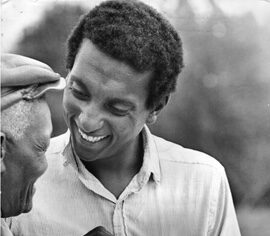From Civil Rights to Black Power: The Radicalization and Decline of the Student Nonviolent Coordinating Committee (SNCC)
In June of 1966, Civil Rights activists from around the country gathered in Mississippi to organize black communities in support of their newly acclaimed voting rights. They rushed to the southern state after James Meredith, who had planned to do a solo March Against Fear to encourage black voter registration, was shot and wounded two days into his journey. Many prominent Civil Rights leaders took over his march along the 220-mile route through the Mississippi Delta, speaking in several cities and helping many African Americans register. That month, no speech stood out as much as Stokely Carmichael’s on June 16 at a rally in Greenwood. When it was his turn to take the stage, the chairman of the Student Nonviolent Coordinating Committee (SNCC) announced a new direction for his organization: Black Power.
Ever since the Mississippi Summer Project of 1964, also known as the Freedom Summer, SNCC had been divided over its future direction. These discussions emerged in the aftermath of the violent responses to their summer activities, as well as the massive influx of white volunteers and recent changes in its institutional structures. Whereas some members wished to remain faithful to SNCC’s original framework and dedication to nonviolence, others had lost faith in the old system and wanted to embrace more radical forms of antiracism. Carmichael’s speech in Greenwood showed that, after nearly two years of internal debates, the organization was ready to publicly announce its decision: SNCC was going to adopt a politics of self-defense and self-determination in order to take back control over black communities, thus joining the growing black nationalist branch of the freedom movement. In the following year, Carmichael’s successor H. Rap Brown changed the organization’s name to Student National Coordinating Committee to formalize this orientational change.
Over the next couple of months, SNCC navigated the emerging Black Power movement while trying to find a place in America’s radical political environment. Many local chapters had already moved away from nonviolence prior to Carmichael’s official announcement and therefore continued their activities as usual. Yet for others, predominantly those in the north, the ideological transformation caused many problems, not least of which was the decreasing financial support of white liberals and northern churches, which almost led SNCC to the brink of bankruptcy by 1967. Meanwhile, national SNCC leadership tried to forge coalitions with other Black Power groups, including the recently established Black Panther Party (BPP). Hoping to merge the organizations into a ‘United Black Front’, former chairman Stokely Carmichael, former executive director James Forman, and chairman H. Rap Brown joined the Panthers as honorary members in 1968. Yet, their coalition lasted less than a year, brought to a halt an armed confrontation between Carmichael and Panther foreman Eldridge Cleaver.
SNCC’s split with the Black Panthers made clear just how far Black Power groups were from finding enough common ground to form a strong, undivided front against racial oppression and injustice in America. Internal conflicts were amplified by FBI involvement in both organizations. SNCC was among the many groups targeted by the bureau’s Counterintelligence Program (COINTELPRO), which aimed to ‘neutralize’ political organizations by infiltrating them with undercover agents. In the case of SNCC, these agents had two tasks: to gather inside information that would help the government discredit the organization, and to cause internal tensions that would disrupt SNCC’s progress. The bureau’s attempts – as well as other setbacks – proved to be successful: by 1969, the majority of SNCC departments had closed their doors and ceased to exist. The Atlanta office and the Mississippi Freedom Democratic Party continued with their programs until 1972.
The RIAS holds two collections on the radicalization and subsequent decline of the organization: the Student Nonviolent Coordinating Committee Papers, 1959-1972 and the FBI File on the Student Nonviolent Coordinating Committee. The first collection consists of documents from SNCC itself, ranging from official files to, for example, internal communication, research reports, financial records, and photographs. The second provides an overview of FBI field reports from nineteen different cities across the United States. These reports contain general information about the local divisions, as well as the bureau’s bases for investigation. Together, these collections provide a well-rounded set of sources on the SNCC history, as well as the Civil Rights and Black Power movements writ large.



